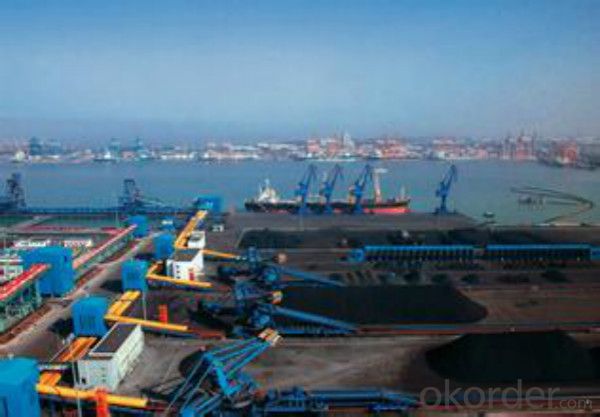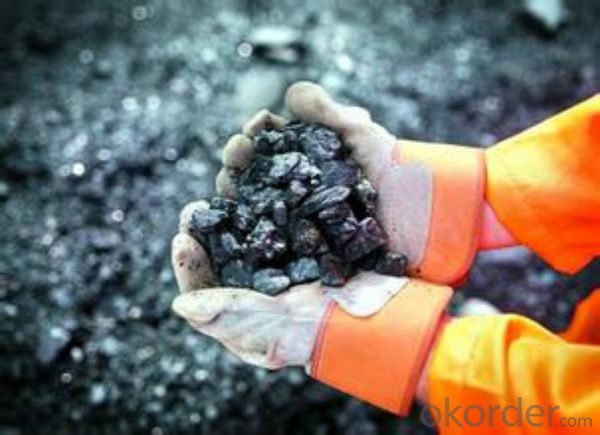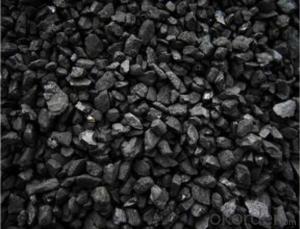90-120mmFoundry Coke Manufactured in China in High Quality
- Loading Port:
- Tianjin
- Payment Terms:
- TT OR LC
- Min Order Qty:
- 1200 m.t
- Supply Capability:
- 20000 m.t/month
OKorder Service Pledge
OKorder Financial Service
You Might Also Like
Product Introduction
Foundry Coke is a kind of main raw materials used for steel making, we have own coke plants at Shanxi province with output 2 million MT.The coke is made from superior coking coal of Shanxi province. Provided with the dvantages of low ash, low sulphur and high carbon.Our coke is well sold in European,American,Japanese and South-east Asian markets.
Features
This is a special coke that is used in furnaces to produce cast and ductile iron products. It is a source of heat and also helps maintain the required carbon content of the metal product. Foundry coke production requires lower temperatures and longer times than blast furnace coke.
Specification
Fixed Carbon | Sulphur Content | Moisture | V.Matter | Ash |
86%min | 0.7%max | 5%max | 1.2%max | 12%max |
88%min | 0.65%max | 5%max | 1.5%max | 10%max |
85%min | 0.8%max | 15%max | 2%max | 13.5%max |
Pictures


FAQ:
1 How long can we deliver the cargo?
Within 30 days after receiving the LC draft or down payment
2 Time for after-sales?
1 year.
3 Cutomized or general specfications?
Both are acceptable
4 Payment terms?
L/C,D/P, T/T with down payment
- Q:How does carbon impact the prevalence of droughts?
- Droughts are significantly influenced by carbon, specifically in the form of carbon dioxide (CO2) emissions. The prevalence of droughts is attributed to the increased levels of carbon in the atmosphere, which contribute to global warming and impact climate patterns globally. Human activities, such as the burning of fossil fuels and deforestation, release carbon dioxide into the atmosphere. This carbon dioxide acts as a greenhouse gas, trapping heat from the sun and causing the Earth's temperature to rise. As the global temperature increases, precipitation patterns and evaporation rates undergo changes. Warmer temperatures accelerate evaporation, leading to more water evaporating from lakes, rivers, and soil. This increased evaporation, combined with altered precipitation patterns, results in drier conditions and reduced water availability in certain regions. Furthermore, the rising temperatures contribute to the intensification of the water cycle, leading to more extreme weather events. These events include more frequent and severe droughts, as well as intense rainfall in some areas, increasing the risk of floods. Moreover, carbon emissions also impact atmospheric circulation patterns, such as the weakening of the jet stream. The jet stream plays a crucial role in directing weather systems across the globe, including rain-bearing weather fronts. When it weakens, weather systems become stagnant, resulting in prolonged drought periods in certain regions. In summary, human activities that increase carbon levels in the atmosphere have a direct influence on global warming and climate change. These changes in climate patterns and atmospheric circulation, along with the intensification of the water cycle, significantly affect the occurrence and severity of droughts worldwide. Therefore, it is essential to reduce carbon emissions and address climate change in order to minimize the impacts of droughts on ecosystems, agriculture, and human populations.
- Q:Isotopes of carbon
- First, 14C dating method14C is the nature of the cosmic rays and atmospheric nitrogen produced by nuclear reactions. The carbon -14 not only exists in the atmosphere, with the absorption and metabolism of the organism, through the food chain into animal or human living organisms. All because of carbon in the generation side and the -14 side, at a constant rate decay, resulting in carbon -14 in nature (including all organisms) ratio and the content of carbon stable isotope -12 content remained unchanged.When the organism dies, due to the decay of carbon The new supersedes the old. stop, the decrease of -14, so the relative ratio of -14 and -12 in carbon carbon content corresponding decrease. By determination of biological fossils unearthed in the medium carbon -14 and carbon content of -12, can accurately calculate the death of the organisms (i.e. survival) in a given organism unearthed. For example the fossil, M grams of carbon (or carbon determination of the quality of -12), according to the relative ratio of various carbon isotope content of nature can be calculated, the organism is alive, the quality of carbon -14 should be m grams. But the actual measured carbon quality of -14 only m grams of 1/8, according to the half-life the biological death has been 3 for 5730 years, has been dead for seventeen thousand two hundred and ninety years. The United States radiochemist W.F. Libby has invented the method of radioactive dating, made outstanding contributions to Archaeology He was awarded the Nobel prize for chemistry in 1960Because of the very low carbon content of -14, and the half-life is very long, so -14 can accurately measure the carbon 5 to within 60 thousand years of the unearthed cultural relics, for older unearthed cultural relics, such as living in five hundred thousand years ago, Zhoukoudian Beijing man, using carbon -14 dating method is not determined to.
- Q:The difference between graphite and carbon
- Graphite is a crystalline mineral of carbonaceous elements, and its crystalline framework is hexagonal layered structure
- Q:How does carbon impact the prevalence of cyclones?
- Carbon emissions and the subsequent increase in atmospheric carbon dioxide levels have a significant impact on the prevalence of cyclones. Cyclones, also known as hurricanes or typhoons, are powerful and destructive weather phenomena that form over warm ocean waters. The increased carbon in the atmosphere, primarily due to human activities such as burning fossil fuels, leads to global warming and alters the climate patterns. Warmer ocean temperatures caused by carbon emissions provide the necessary fuel for cyclones to form and intensify. As carbon dioxide traps heat in the atmosphere, it warms the surface of the oceans, creating a favorable environment for cyclone development. The warmer the ocean waters, the more energy is available for cyclones to grow and become more destructive. Additionally, carbon emissions contribute to the changing climate patterns, leading to shifts in atmospheric circulation patterns. These changes can influence the frequency, intensity, and track of cyclones. While it is difficult to attribute individual cyclones to carbon emissions, scientific studies show that the overall increase in carbon dioxide levels is contributing to a greater number of severe cyclones in certain regions. Furthermore, the rising sea levels associated with global warming and carbon emissions can exacerbate the impact of cyclones. Higher sea levels lead to increased storm surge, which is the abnormal rise in water level during a cyclone. This storm surge can cause devastating flooding in coastal areas and result in significant damage to infrastructure and loss of life. In conclusion, carbon emissions have a profound impact on the prevalence of cyclones. The increased atmospheric carbon dioxide levels contribute to warmer ocean temperatures, creating a more favorable environment for cyclone formation and intensification. Changes in climate patterns due to carbon emissions also affect the frequency and track of cyclones. Additionally, rising sea levels associated with global warming can worsen the impact of cyclones through increased storm surge. It is crucial for society to address carbon emissions and work towards sustainable solutions to mitigate the impacts of cyclones and other severe weather events.
- Q:What about my world carbon board?
- First put the coal into the crusher and crush it into carbon powder (some versions are pulverized coal), so that they can be synthesizedCarbon powder, carbon fiberToner carbon powderCarbon fiber = carbon mesh (as if by name)Carbon fiber n.Put the carbon mesh into the compressor and compress the carbon plate
- Q:How does carbon impact air quality?
- Carbon impacts air quality through the release of carbon dioxide (CO2) and other greenhouse gases during the combustion of fossil fuels. These emissions contribute to the greenhouse effect, trapping heat in the atmosphere and causing global warming. Additionally, carbon particles from incomplete combustion, like soot, can reduce air quality by causing respiratory issues and forming smog.
- Q:What are the carbon nanotube applications?
- The hydrogen storage materials: gas adsorption in adsorption is a solid adsorbent surface behavior the occurrence process of adsorbent and solid surface characteristics are closely related. The adsorption mechanism of nanoparticles, it was generally accepted that adsorption of carbon nanotubes is mainly due to the surface hydroxyl carbon nanotubes nanoparticles. The effect of carbon nanotubes on the surface of to hydroxyl and certain cationic bonding, so as to achieve the apparent of metal ions or organic matter adsorption. In addition, carbon nanotube particles have a large surface area, is also an important reason for the adsorption of carbon nanotubes. Zheng Qingrong, Gu Anzhong and [4] were studied on the adsorption behavior of hydrogen in carbon nanotubes Cheng Hui Ming et al. Synthesis of SWNTS treated properly can store hydrogen at room temperature, the hydrogen storage weight of up to 4.2%, and 78.3% of the hydrogen storage under normal temperature and pressure The hydrogen is released, and the remaining hydrogen is released after heating. The SWNTS can be reused and has a high commercial valueThe proton exchange membrane fuel cell (PEM) is a new type of carbon nanotubes: fuel cell vehicle power supply the most potential, the fuel cell through the consumption of hydrogen to generate electricity, the exhaust gas discharged into water vapor, therefore no pollution. It is compared with the lithium ion battery and Ni MH battery has great superiority. Can use carbon nanotubes hydrogen storage material supply hydrogen, can also be through the decomposition of oil and gas and other hydrocarbons or directly from the air to obtain hydrogen fuel cell hydrogen source.
- Q:What are the properties of carbon nanotubes?
- Cylindrical structures made entirely of carbon atoms are known as carbon nanotubes. They possess a distinct set of properties that make them highly sought after in various fields of science and technology. Some of the notable properties of carbon nanotubes are as follows: 1. Remarkable strength and stiffness: Carbon nanotubes have an exceptional strength-to-weight ratio, making them one of the strongest materials discovered so far. They are approximately 100 times stronger than steel, yet significantly lighter. This characteristic renders them suitable for applications requiring lightweight materials with high strength. 2. Excellent electrical conductivity: Carbon nanotubes exhibit excellent electrical conductivity, enabling efficient flow of electrical current. They can be utilized as conductive components in diverse electronic devices, including transistors, sensors, and energy storage systems. 3. Efficient thermal conductivity: Carbon nanotubes possess high thermal conductivity, allowing efficient heat transfer. This property makes them ideal for applications requiring effective dissipation of heat, such as thermal management in electronic devices. 4. Flexibility and resilience: Carbon nanotubes are highly flexible and can endure substantial deformation without fracturing. They can be bent and twisted without compromising their structural integrity, making them suitable for applications demanding flexibility, such as flexible electronics. 5. Unique optical and mechanical properties: Carbon nanotubes possess distinctive optical properties that vary depending on their structure and arrangement. They can absorb and emit light across a wide range of wavelengths, making them valuable in applications like photodetectors and solar cells. Additionally, their mechanical properties, including elastic deformation, contribute to their usefulness in applications requiring shock absorption and impact resistance. 6. Chemical stability: Carbon nanotubes exhibit high chemical stability, enabling them to resist degradation or corrosion when exposed to different chemical environments. This characteristic makes them suitable for applications in harsh conditions or as protective coatings. 7. Large aspect ratio: Carbon nanotubes possess a high aspect ratio, with lengths often exceeding thousands of times their diameter. This characteristic allows them to form robust and lightweight composite materials when integrated into a matrix, enhancing the overall strength and stiffness of the composite. In conclusion, the combination of properties displayed by carbon nanotubes makes them an intriguing and versatile material with enormous potential in various applications, including electronics, aerospace, medicine, and energy storage.
- Q:when to use hard carbon, and when to use soft carbon. Neutral charcoal can play what role? Thank you.
- Soft charcoal as easily broken, so soft to the name. Hard charcoal is not easy to break, of course, also called hard charcoal. Models are generally marked with charcoal, it is easy to distinguish. When used, you can also judge.
- Q:How does carbon affect the formation of cyclones?
- Carbon does not directly affect the formation of cyclones. Cyclones, also known as hurricanes or typhoons, are formed through a complex interaction of various atmospheric and oceanic factors. Carbon, specifically carbon dioxide (CO2), is a greenhouse gas that contributes to global warming and climate change. It is important to note that while carbon dioxide concentrations in the atmosphere are increasing due to human activities, such as burning fossil fuels, it does not directly cause the formation of cyclones. However, climate change resulting from increased carbon dioxide levels does have an indirect influence on cyclone formation. Warmer temperatures due to climate change can lead to increased sea surface temperatures, which provide the energy necessary for cyclone formation and intensification. Higher temperatures also increase evaporation rates, leading to more moisture in the atmosphere that can fuel cyclone development. Furthermore, climate change can alter atmospheric conditions and circulation patterns, which may affect the frequency, intensity, and tracks of cyclones. However, the specific impact of carbon dioxide on cyclone formation and behavior is still an active area of research, and more studies are needed to fully understand the relationship between carbon dioxide and cyclones.
1. Manufacturer Overview |
|
|---|---|
| Location | |
| Year Established | |
| Annual Output Value | |
| Main Markets | |
| Company Certifications | |
2. Manufacturer Certificates |
|
|---|---|
| a) Certification Name | |
| Range | |
| Reference | |
| Validity Period | |
3. Manufacturer Capability |
|
|---|---|
| a)Trade Capacity | |
| Nearest Port | |
| Export Percentage | |
| No.of Employees in Trade Department | |
| Language Spoken: | |
| b)Factory Information | |
| Factory Size: | |
| No. of Production Lines | |
| Contract Manufacturing | |
| Product Price Range | |
Send your message to us
90-120mmFoundry Coke Manufactured in China in High Quality
- Loading Port:
- Tianjin
- Payment Terms:
- TT OR LC
- Min Order Qty:
- 1200 m.t
- Supply Capability:
- 20000 m.t/month
OKorder Service Pledge
OKorder Financial Service
Similar products
New products
Hot products





























